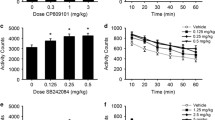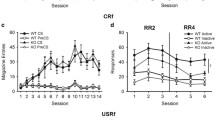Abstract
Studies from this laboratory have demonstrated that administration of the selective 5-HT2/1C antagonist LY53857 can block 5-HTP-induced response suppression. To further investigate the serotonergic mechanisms involved in this effect, we decided to test the capacity of LY53857 to block response suppression induced with two selective 5-HT agonists. After a 15 minute baseline period, rats trained to press a lever for milk reinforcement on a VI 1′ schedule were given IP injections of 1.0 mg/kg DOI, or 1.0 mg/kg 8-OH-DPAT to induce response suppression. Subsequently, rats were injected with 1.0 mg/kg LY53857 1 hour prior to DOI- or 8-OH-DPAT-induced response suppression. Preinjections with LY53857 resulted in a 100% blockade of DOI-induced response suppression whereas the same dose did not block response suppression induced with 8-OH-DPAT. These results indicate that the 5-HTP-induced response suppression shows some pharmacological similarity to DOI-induced response suppression and may be mediated through 5-HT2 and/or 5-HT1C receptors.
Similar content being viewed by others
References
Aprison, M. H., and Ferster, C. B. 1960. Behavioral effects of 5-hydroxytryptophan. Experientia 16:159–160.
Aprison, M. H., and Ferster, C. B. 1961. Neurochemical correlates of behavior. I. Quantitative measurement of the behavioral effects of serotonin precursor 5-hydroxytryptophan. J. Pharmacol. Exp. Ther. 131:100–107.
Aprison, M. H., Wolf, M. A., Poulos, G. L., and Folkerth, T. L. 1962. Neurochemical correlates of behavior. III. Variation of serotonin content in several brain areas and peripheral tissues of the pigeon following 5-hydroxytryptophan administration. J. Neurochem. 9:575–584.
Aprison, M. H., and Hingtgen, J. N. 1972. Serotonin and behavior: A brief summary. Fed. Proc. 31:121–129.
Aprison, M. H., and Hingtgen, J. N. 1966. Differential drug effects on approach and avoidance behavior in rats with related changes in brain serotonin and norepinephrine, Rec. Adv. Biol. Psychiat. 8:87–100.
Aprison, M. H., and Hingtgen, J. N. 1965. Neurochemical correlates of behavior. IV. Norepinephrine and dopamine in four brain parts of the pigeon during period of atypical behavior following the injection of 5-hydroxytryptophan. J. Neurochem. 12:959–968.
Park, W. K., Hingtgen, J. N., and Aprison, M. H. 1991. Differential effect of 5-hydroxytryptophan on approach and avoidance behavior in rats. Pharm. Biochem. Behav. 38:191–194.
Brugge, K. L., Hingtgen, J. N., and Aprison, M. H. 1987. Potentiated 5-hydroxytryptophan induced response suppression in rats following chronic reserpine. Pharm. Biochem. Behav. 26:287–291.
Engleman, E. A., Hingtgen, J. N., Zhou, F. C., Murphy, J. M., and Aprison, M. H. 1991. Potentiated 5-hydroxytryptophan response suppression following 5,7-dihydroxytryptamine raphe lesions in an animal model of depression. Biol. Psychiat. 30:317–320.
Fleisher, L. N., Simon, J. R., and Aprison, M. H. 1979. A biochemical-behavioral model for studying serotonergic supersensitivity in brain. J. Neurochem. 32:1613–1619.
Hellhammer, D. H., Hingtgen, J. N., Wade, S. E., Shea, P. A., and Aprison, M. H. 1983. Serotonergic changes in specific areas of rat brain associated with activity-stress gastric lesions. Psychosom. Med. 45:115–122.
Mayeda, A. R., Simon, J. R., Hingtgen, J. N., Hofstetter, J. R., and Aprison, M. H. 1989. Activity wheel stress and serotonergic hypersensitivity in rats. Pharm. Biochem. Behav. 33:349–353.
Nagayama, H., Hingtgen, J. N., and Aprison, M. H. 1981. Postsynaptic action by four antidepressant drugs in an animal model of depression. Pharm. Biochem. Behav. 15:125–130.
Hingtgen, J. N., Hendrie, H. C., and Aprison, M. H. 1984. Postsynaptic serotonergic blockade following chronic antidepressive treatment with trazodone in an animal model of depression. Pharm. Biochem. Behav. 20:425–428.
Papeschi, R., and McClure, D. J. 1971. Homovanillic and 5-hydroxyindoleacetic acid in cerebrospinal fluid of depressed patients. Arch. Gen. Psychiat. 25:354–361.
Goodwin, F. K., and Post, R. M. 1974. Brain serotonin, affective illness, and antidepressant drugs: cerebrospinal fluid studies with probenecid. Adv. Biochem. Psychopharmacol. 11:34–47.
Aprison, M. H., Takahashi, R., and Tachiki, K. 1978. Hypersensitive serotonergic receptors involved in clinical depression — A Theory. Pages 23–53,in B. Haber and M. H. Aprison (eds.), Neuropharmacology and Behavior, Plenum Press, New York.
Aprison, M. H., and Hingtgen, J. N. 1986. A hypersensitive serotonergic receptor theory of depression: the role of stress. Pages 443–460.in R. C. A. Frederickson, H. C. Hendrie, J. N. Hingtgen and M. H. Aprison (eds.), Neuroregulation of Autonomic, Endocrine and Immune Systems, Martinus Nijhoff, Boston.
Blackshear, M. A., and Sanders-Bush, E. 1982. Serotonin receptor sensitivity after acute and chronic treatment with mianserin. J. Pharmacol. Exp. Ther. 221:303–308.
Gandolfi, O., Barbaccia, M. L., and Costa, E. 1985. Different effects of serotonin antagonists on3H-Mianserin and3H-Ketanserin recognition sites. Life Sci. 36:713–721.
May, P. C., Morgan, D. G., and Finch, C. E. 1986. Regional serotonin receptor studies: chronic methysergide treatment induces a selective and dose-dependent decrease in serotonin-2 receptors in mouse cerebral cortex. Life Sci. 38:1741–1747.
Arora, R. C., and Meltzer, H. Y. 1989. Serotonergic measures in the brains of suicide victims: 5-HT2 binding sites in the frontal cortex of suicide victims and control subjects. Amer. J. Psychiat. 146:730–736.
Yates, M., Leake, A., Candy, J. M., Fairbaim, A. F., McKeith, I. G., and Ferrier, I. N. 1990. 5-HT2 receptor changes in major depression. Biol. Psychiat. 27:489–496.
Cheetham, S. C., Crompton, M. R., Katona, C. L. E., et al 1988. Brain 5-HT2 receptor binding sites in depressed suicide victims. Brain Res. 443:272–280.
Hingtgen, J. N., Fuller, R. W., Mason, N. R., and Aprison, M. H. 1985. Blockade of a 5-hydroxytryptophan-induced animal model of depression with a potent and selective 5-HT2 receptor antagonist (LY 53857). Biol. Psychiat. 20:592–597.
Nagayama, H., Hingtgen, J. N., and Aprison, M. H. 1980. Pre- and postsynaptic serotonin manipulations in an animal model of depression. Pharm. Biochem. Behav. 13:575–579.
Corne, S. J., Pickering, R. W., and Warner, B. T. 1963. A method for assessing the effects of drugs on the central actions of 5-hydroxytryptamine. Br. J. Pharmacol. 20:106–120.
Grahame-Smith, D. G. 1971. Studies in vivo on the relationship between brain tryptophan, brain 5-HT synthesis and hyperactivity in rats treated with a monoamine oxidase inhibitor andl-tryptophan. J. Neurochem. 18:1053–1066.
Jacobs, B. L. 1976. An animal model for studying central serotonergic synapses. Life Sci. 19:777–786.
Tricklebank, M. D., Forler, C., and Fozard, J. R. 1984. The involvement of subtypes of the 5-HT1 receptor and of catecholaminergic systems in the behavioural response to 8-hydroxy-2-(di-n-propylamino) tetralin binding in the rat. Eur. J. Pharmacol. 106:271–282.
Goodwin, G. M., DeSouza, R. J., Green, A. R., and Heal, D. J. 1987. The pharmacology of the behavioural and hypothemic responses of rats to 8-hydroxy-2-(di-n-propylamino) tetralin (8-OH-DPAT). Psychopharmacology 91:506–511.
Green, A. R., and Backus, L. I. 1990. Animal models of serotonin behavior. Ann. N.Y. Acad. Sci. 600:237–249.
Bedard, P., and Pycock, C. J. 1977. ‘Wet-dog’ shake behavior in the rat: a possible quantitative model of central 5-hydroxytruptamine activity. Neuropharmacology 16:663–670.
Hingtgen, J. N., Shekhar, A., DiMicco, J. A., and Aprison, M. H. 1988. Response suppression in rats after bilateral microinjection of 5-hydroxytryptophan in lateral hypothalamus. Biol. Psychiat. 23:711–718.
Hingtgen, J. N., and Aprison, M. H. 1975. Behavioral depression in pigeons followingl-tryptophan administration. Life Sci. 16:1471–1476.
Smith, J. E., Hingtgen, J. N., Lane, J. D., and Aprison, M. H. 1976. Neurochemical correlates of behavior. Content of tryptophan, 5-hydroxytryptophan, serotonin, 5-hydroxyindoleacetic acid, tyrosine, dopamine, and norepinephrine in four brain parts of the pigeon during behavioral depression following an injection of tryptophan. J. Neurochem. 26:537–541.
Goodwin, G. M., Green, A. R., and Johnson, P. 1984. 5-HT2 receptor characteristics in frontal cortex and 5-HT2 receptor mediated head-twitch behaviour following antidepressant treatment to mice. Br. J. Pharmacol. 83:235–242.
Author information
Authors and Affiliations
Additional information
Special issue dedicated to Dr. Morris H. Aprison
Rights and permissions
About this article
Cite this article
Engleman, E.A., Murphy, J.M., Zhou, F.C. et al. Response suppression induced with selective 5-HT agonists can be differentially blocked with LY53857 in an animal model of depression. Neurochem Res 17, 483–488 (1992). https://doi.org/10.1007/BF00969896
Accepted:
Issue Date:
DOI: https://doi.org/10.1007/BF00969896




